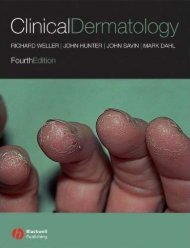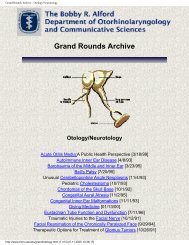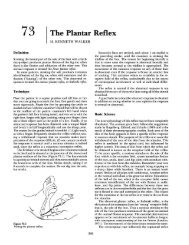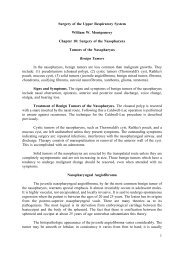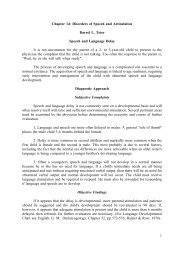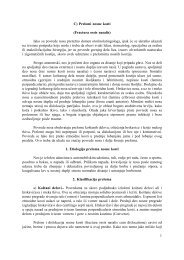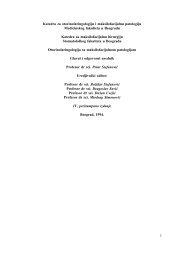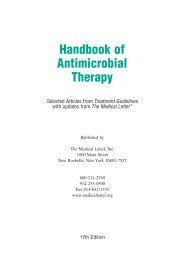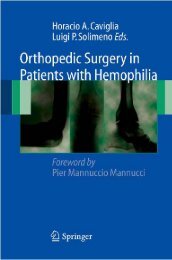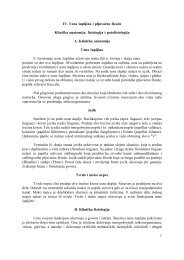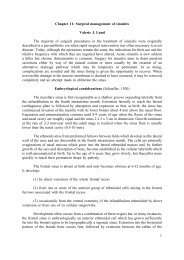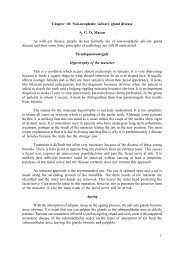1 Chapter 13: Acute suppurative otitis media and acute mastoiditis ...
1 Chapter 13: Acute suppurative otitis media and acute mastoiditis ...
1 Chapter 13: Acute suppurative otitis media and acute mastoiditis ...
Create successful ePaper yourself
Turn your PDF publications into a flip-book with our unique Google optimized e-Paper software.
psychotic symptoms, especially in children, the conclusion is inescapable that their use is<br />
unwise.<br />
Topical decongestants are also widely prescribed but the passage of drops or nebulized<br />
particles through the nose <strong>and</strong> nasopharynx seems hardly likely to produce a useful effect on<br />
the eustachian tube. Lilholdt et al (1982) did not find any improvement in eustachian tube<br />
function in children with proved severe tubal dysfunction after their noses were sprayed with<br />
either oxymetazoline hydrochloride or placebo. The use of topical decongestants in <strong>acute</strong><br />
<strong>suppurative</strong> <strong>otitis</strong> <strong>media</strong> is not recommended as they are unlikely to produce a useful effect<br />
on the eustachian tube.<br />
Surgical treatment<br />
While the vast majority of ears with <strong>acute</strong> <strong>suppurative</strong> <strong>otitis</strong> <strong>media</strong> will respond to the<br />
above regimen of appropriate antibiotics, bed-rest <strong>and</strong> analgesia, <strong>and</strong> while some tympanic<br />
membranes will rupture spontaneously with or without treatment, in a very small minority<br />
there is persistence of pain <strong>and</strong> temperature with a red bulging tympanic membrane despite<br />
adequate medical management. Myringotomy should then be undertaken with a view to<br />
releasing pus accumulating under pressure.<br />
The operation is carried out under general anaesthesia using an operating microscope,<br />
<strong>and</strong> with full aseptic procedures. The patient is placed supine on the operating table with the<br />
head turned to one side. Using an aural speculum <strong>and</strong> angled myringotome, a radial incision<br />
is made in the posteroinferior segment; the maximum bulging is posterior in <strong>acute</strong> <strong>suppurative</strong><br />
<strong>otitis</strong> <strong>media</strong>, <strong>and</strong> the inferior incision avoids the risk of damaging the ossicular chain, chorda<br />
tympani <strong>and</strong> facial nerve. Pus then gushes out under pressure, <strong>and</strong> a swab is taken <strong>and</strong> sent<br />
for culture <strong>and</strong> sensitivities. Residual pus is gently sucked out. The incision should be about<br />
3-4 mm in length; tiny incisions tend to heal too quickly <strong>and</strong> allow put to reaccumulate in the<br />
middle ear cleft. Ventilation tubes should not be inserted in <strong>acute</strong> <strong>suppurative</strong> <strong>otitis</strong> <strong>media</strong>.<br />
Postoperatively, on recovering from anaesthesia the patient will usually say that the<br />
earache has disappeared, <strong>and</strong> generally the temperature quickly returns to normal. Antibiotic<br />
treatment is continued until resolution is virtually complete, but the regimen is changed if<br />
necessary as soon as the results of the swab taken at operation are known.<br />
Prophylactic treatment<br />
Long-term daily treatment with antibiotics or sulphamethoxazole has been shown to<br />
be effective in reducing the number of episodes in patients prone to <strong>acute</strong> <strong>suppurative</strong> <strong>otitis</strong><br />
<strong>media</strong>. However, all antibiotics are potentially toxic <strong>and</strong> long-term prophylaxis with oral<br />
antibiotics is not generally recommended as the risks may be greater than the risk of another<br />
attack of <strong>acute</strong> <strong>suppurative</strong> <strong>otitis</strong> <strong>media</strong>. (Note that this statement applies only to recurrent<br />
<strong>acute</strong> <strong>suppurative</strong> <strong>otitis</strong> <strong>media</strong> <strong>and</strong> it is recognized that there may be a place for such<br />
prophylaxis in other conditions.) Occasionally <strong>acute</strong> <strong>suppurative</strong> <strong>otitis</strong> <strong>media</strong> occurs so<br />
frequently <strong>and</strong> with such severity that a trial of continuous antibiotic treatment, especially in<br />
the winter, is justified.<br />
<strong>13</strong>




